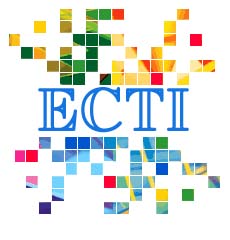2D Interleaver Design for Image Transmission over Severe Burst-Error Environment
Main Article Content
Abstract
This paper proposes to further design the sub-optimal two-dimensional (2D) interleavers while taking the best interleaver from the previous work into consideration. The newly proposed interleavers are 2D Golden interleavers (Gold), uniformly distributed interleavers (Uniform) and Block and bit wise interleavers (Block & bit). The performances of these interleavers were compared and evaluated by comparing the average (Mean) and standard deviation (SD) of the bit error rate (BER) under the environments with different amounts of burst errors. Moreover, the average computation time (Time) of the interleaver and average distance between adjacent bits after deinterleaving (Dist) were also utilized as the criteria for performance evaluation. Time could also be used to analyze the computational complexity of the interleavers where Time of the proposed 2D interleaver was compared with Time of original 1D block interleaver to test the suitability for hardware accomplishment. The transmission scheme for 2D system is based on previously proposed 2D linear block code and 2D syndrome decoder. The performances of these 2D interleavers were compared with traditional one-dimensional (1D) interleavers with comparably the same complexity. The buffer sizes for 2D channel that were considered in this paper are 256*256, 128*128, 64*64, 32*32 and 16*16 which is equivalent to 65536, 16384, 4096, 1024 and 256 buffer sizes for 1D respectively as they have the same number of elements. Simulation results suggest that 2D interleavers have relatively lower computation time than their 1D equivalent interleavers and reducing the buffer size can dramatically increase the BER. The optimal buffer sizes for 2D interleavers are 256*256 and 128*128. For low error rate error, the best interleaver would be Uniform and Gold for 256*256 and 128*128 buffer size respectively. For the other environment, the finest ones are Block&bit and Uniform for 256*256 and 128*128 buffer size respectively. Comparison results between the computation time of the proposed 2D interleavers and 1D block interleaver also indicate that 2D interleavers are suitable for hardware implementation since they have less computational complexity.
Article Details
This journal provides immediate open access to its content on the principle that making research freely available to the public supports a greater global exchange of knowledge.
- Creative Commons Copyright License
The journal allows readers to download and share all published articles as long as they properly cite such articles; however, they cannot change them or use them commercially. This is classified as CC BY-NC-ND for the creative commons license.
- Retention of Copyright and Publishing Rights
The journal allows the authors of the published articles to hold copyrights and publishing rights without restrictions.
References
[2] I. A. Glover, and P. M. Grant, Digital Communications, 2nd ed., Pearson Prentice-Hall, Great Britain, 2004.
[3] A. Goldsmith, Wireless communications, Cambridge University Press, 2005.
[4] M. Shukla, "Performance analysis of optimum interleaver based on prime numbers for multiuser iterative IDMA systems," IGI Int. J. Interdisci- plinary Telecommun. Networking, vol. 2, no. 3, pp. 51-65, Oct. 2010.
[5] S. Crozier, J. Lodge, P. Guinand, and A. Hunt, "Performance of turbo codes with relative prime and golden interleaving strategies," Proc. the 6th Int. Mobile Satellite Conf., Ottawa, Ontario,
Canada, 1999, pp. 268-275.
[6] R. Johannesson, and K. S. Zigangirov, Fundamentals of Convolutional Coding, IEEE Press, New York, 1999.
[7] C. Charoenlarpnopparut, "Applications of groebner bases to the structural description and realization of multidimensional convolutional code," Sci. Asia, vol. 35, no. 1, pp. 95-105, Mar. 2009.
[8] P. Wiener, Multidimensional Convolutional Codes, Ph.D. Dissertation, University of Notre Dame, 1998.
[9] P. Jangisarakul, and C. Charoenlarpnopparut, "Algebraic decoder of multi-dimensional convolutional code: constructive algorithms for determining syndrome decoder matrix based on groebner basis," Multidimensional Systems and Signal Processing, vol. 22, no. 1-3, pp. 67-81, Mar. 2011.
[10] E. O. Elliott, "Estimates of error rates for codes on burst-noise channels," Bell Syst. Technology J., vol. 42, no. 5, pp. 1977-1997, Sept. 1963.
[11] E. N. Gilbert, "Capacity of burst-noise channel," Bell Syst. Technology J., vol. 39, no. 5, pp. 1253-1265, Sept. 1960.
[12] Frank Kschischan, (2007), Error control code [Online], Available: http://www.comm.utoronto.ca/frank/ece1501/protected/2007/lecture04.pdf
[13] Jose Micola, and Oscar Juvill, (2000), Hamming block code [Online], Available: web.udl.es/usuaris/carlesm/docencia/xc1/Treballs/Hamming.Treball.pdf
[14] C. Charoenlarpnopparut, P. Jangisarakul, and A. Thamrongmas, "Two-dimensional block code design: code search and syndrome decoder," submitted for publication.
[15] C. Charoenlarpnopparut, S. Suprasongsin, P. Jangisarakul, and A. Thamrongmas, "Performance evaluation of image transmission system with two-dimensional linear block code and interleaver," Int. Conf. Inform. Commun. Tech. Embedded Syst., Samutsongkhram, Thailand, 2013, pp. 174-177.
[16] P. Hanpinitsak, and C. Charoenlarpnopparut, "2D interleaver design for image transmission over severe burst error environment," Int. J. Future Comput. Commun., vol. 2, no. 4, pp. 308-312, Aug. 2012.
[17] A. E. Brouwer and T. Verhoeff, "An updated table of minimum-distance bounds for binary linear codes,"IEEE Trans. Inform. Theory, vol. 39, no. 2, pp. 662-677, Mar., 1993.


